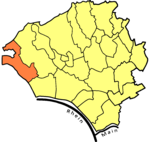Klarenthal is a borough of Wiesbaden, capital of the federal state of Hesse, Germany. The community, situated on the slopes of the Taunus Mountains, was planned by architect and urban planner Ernst May in the style of a commuter town in the early 1960s. It was built on free arable land between the railway line to Bad Schwalbach and Klarenthaler Straße, overlooking the city center of Wiesbaden proper. Klarenthal consists mainly of large multi-family homes and residential high-rise buildings, surrounded with much green space, as well as many townhouses. The ground-breaking ceremony was held on September 11, 1964 and the first residents moved in in late February 1966. Today, over 10,000 people live there.
The name comes from the medieval Kloster Klarenthal (Klarenthal Monastery), which was located nearby on the edge of today's settlement, in Wellritztal. The monastery was established by Count Adolf of Nassau (born before 1250; died July 2, 1298), who was elected King of Germany on May 5, 1292. The monastery was to serve as a tomb for the House of Nassau, and his wife Queen Imagina and many of his descendants were buried here. Kloster Klarenthal was the only monastery of the city of Wiesbaden. Its nuns belonged to the Order of Poor Ladies (also known as the Order of Saint Clare or the Poor Clares), which was founded by Clare of Assisi, hence the name Klarenthal. The monastery was secularized in 1559, after the Protestant Reformation. Only a few buildings are still preserved today.








